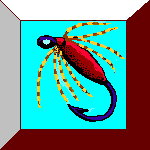


The three genera of the family Caenidae constitute North America's smallest mayflies, with the average size of about 4 mm. Despite their minute dimensions, they are of tremendous importance to the angler. The most significant characteristic of the nymphs are the operculate gills of segment 2, which almost completely cover the ones behind. The nymphs are sprawlers, have three tails, and are densely covered with fine hairs. Adults have whitish, well-developed wings, displaying few crossveins and no marginal intercalary veins. The lateral ocelli are very prominent, and hind wings are absent.

Members of this genus create some of the best fishing of the season, due mainly to the fact that they occur in fantastic numbers for such a long period of time. Nymphs have three tails and rather robust bodies, which are covered with fine hairs. The enlarged, platelike gills borne by segment 2 are triangular in shape and conceal the gills of segments 3 to 6. Wings of the adult have crossveins and are longer in relation to their width than in Caenis and Brachycercus. Bodies have a heavy thorax and are usually blackish or dark brown in color. The general coloration gives the impression of a black insect with white wings. Adults have three tails, with those of the male normally being at least three times as long as the body. A pair of small, knoblike projections is located near the back of the head in both sexes.